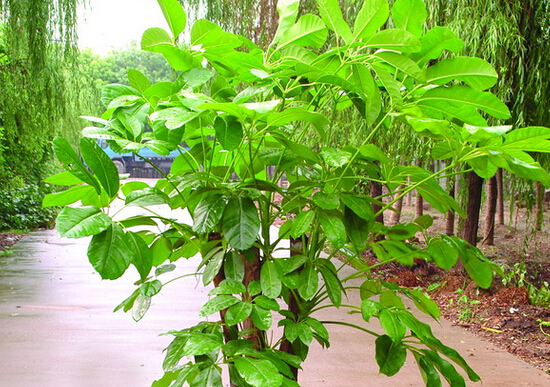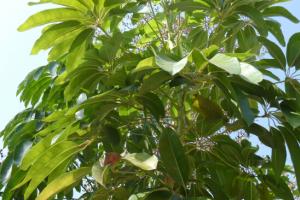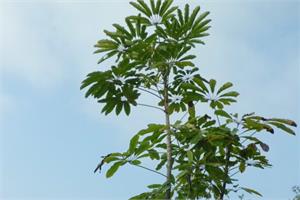What is the best way to cultivate large leaf umbrellas?
Big leaf umbrella is a kind of indoor plant, many people will buy it and put it in the living room or bedroom as decoration, but many people do not know much about it, so, what is the breeding method of big leaf umbrella? The following editor introduces to you, let's have a look at it.

What is the breeding method of umbrellas?
Large leaf umbrella stem erect, less branched, twigs green, brown later, smooth. Green. Glossy, light green on the back. Petiole reddish brown, 5-10 cm long. The breeding method of big leaf umbrella is very simple. Large-leaf umbrellas can be propagated by sowing and cutting. When sowing, it is best to sow the seeds immediately after harvest, so that the germination rate is high. It can be cut in spring, summer and autumn, and it is generally combined with shaping; the irregular plant is cut off 10-15 meters from the surface of the basin soil, so that the mother branch can germinate several branches and cultivate a good tree shape. The cut semi-lignified branches were inserted into the bed cultured in river sand or perlite to maintain a certain substrate humidity and air humidity, and pay attention to shading.
The pot cultivation of umbrella tree can use the mixture of garden soil and rotten leaf soil as the substrate. Avoid direct sunlight in summer, pay attention to proper shade, lest the leaves lose luster or burn, withered and yellow. Indoor furnishings should be placed in a place with diffuse light and pay attention to ventilation. At the end of autumn and winter, the amount of water should be reduced and the amount of fertilizer should be controlled; anthracnose or shell insects and red spiders will occur in greenhouse and indoor conditions of high temperature, humidity and poor ventilation, so attention should be paid to observation and timely prevention.
Temperature: the most suitable temperature for growth is 20-30 ℃. High temperature in summer is beneficial to plant growth. Not cold-resistant, when the temperature is low, it is easy to produce fallen leaves, even leaving only light to dry. It is best to keep 18-20 ℃ in winter, and the overwintering temperature should not be lower than 5 ℃.
Lighting: bogey sun exposure, May-September strong light should be properly shaded, cover 30% of the light, 40% of the light, otherwise the leaves will lose their due luster until they burn and turn yellow. In particular, do not suddenly transfer the plants placed in the shade to places with strong light, so as not to burn the leaves and scorch the leaves. Give plenty of sunshine the rest of the time.
Watering: adequate watering should be made during the growth period to keep the basin soil moist, especially in summer when the growth is exuberant, it is necessary to replenish water in time to promote plant growth. But also avoid too wet, otherwise the leaves droop and lose their luster, the leaves fall off, or even the roots of the plant rot and the whole plant dies. Watering in the growing season should be mastered "do not dry, do not water, water will be thoroughly". The dripping water should be controlled in winter to keep the basin soil dry.
Fertilization: nitrogen-based fertilizer should be applied 1-2 times a month during the growth period to promote the growth of branches and leaves and the hypertrophy and brightness of leaves. After autumn, stop applying nitrogen fertilizer and apply potash fertilizer alone to improve the cold resistance of the plant. Stop fertilizing in winter.
Pruning: coring should be carried out when the seedling is 15-20 cm high to promote branching. Because there are few natural branches, with the gradual shedding of the lower old leaves, the lower part of the plant will collapse when it grows to a certain height, so the topping should be combined with turning the basin every spring to promote branching, control the height and form a good plant shape.
Potting and turning: when the propagated seedlings grow to an appropriate size, they can be boiled in spring. Planting can choose a basin with a diameter of 25-30 cm, with 3-4 plants in each basin. The basin will be turned once every 2-3 years. Like loose, fertile, well-drained slightly acidic soil, avoid alkaline soil and clayey soil. The matrix can be prepared with rotten leaf soil, peat soil, garden soil, sawdust or plain sand and other materials.
The editor reminds us that if there are problems in breeding big leaf umbrellas, do not panic, first go to the Internet to see how to solve, must be cured in time, and it is best to do some prevention work.
Related
- Wuhan Hospital Iron Tree Blooming Result Was Instantly Frightened by the Gardener Master
- Which variety of camellia is the most fragrant and best? Which one do you like best?
- What is the small blue coat, the breeding methods and matters needing attention of the succulent plant
- Dormancy time and maintenance management of succulent plants during dormancy
- Minas succulent how to raise, Minas succulent plant pictures
- What are the varieties of winter succulent plants
- How to raise succulent plants in twelve rolls? let's take a look at some experience of breeding twelve rolls.
- Attention should be paid to water control for succulent plants during dormant period (winter and summer)
- Watering experience of twelve rolls of succulent plants
- Techniques for fertilizing succulent plants. An article will let you know how to fertilize succulent plants.



